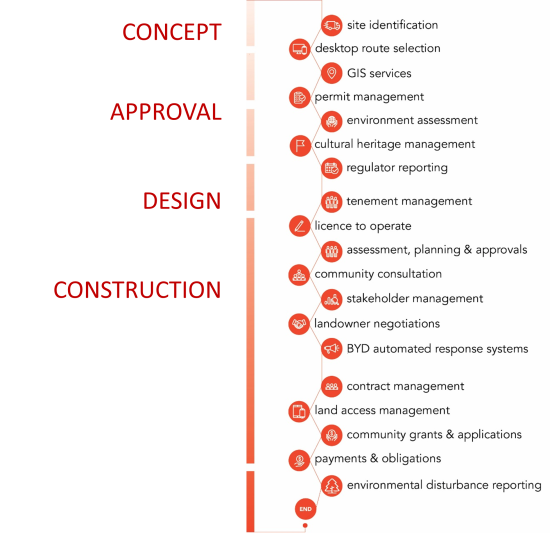Supporting Australia’s Renewable Energy Zones
Extract from Energy New Bulletin article – Analysis: Inside Australia’s REZ pipeline 30 September 2025
Over the past three years, the phrase ‘renewable energy zone’ has increasingly crept into policy papers, press releases and political talking points. Federal and state governments alike have spruiked their creation as a central plank of Australia’s transition strategy.
The idea is simple enough – cluster new generation, transmission and industry in designated hubs where wind, solar, hydro and storage resources overlap. The hope is this not only accelerates decarbonisation but also cuts costs and minimises disruption to the grid.
Renewable energy zones – let’s call them REZs – are the on-shore cousins of the Commonwealth’s offshore wind “declared areas.” They identify where strong wind and solar resources overlap with grid capacity, then funnel new generation and storage into those corridors in a coordinated way.
How the model works
Think of it like a funnel:
- Government defines a REZ boundary and modelled hosting capacity
- A transmission project and operator are progressed
- Developers bid for “access rights” to connect
- Winning projects still need normal state and federal planning or environmental approvals
- Steel only goes in the ground when access rights, planning consent and transmission delivery line up.
So, where does Mipela fit in?
We have often referred to the lifecycle of a project or an asset, as shown in the following diagram. Along the way, there are several activities that take place that require engagement with stakeholders and landholders. These needs change as each project matures but the core data remains consistent.
Mipela specialises in providing software solutions to best manage these processes including it’s commercial off the shelf software called X-Info Stakeholder Management. X-Info Stakeholder Management is designed to get a new project up and running for stakeholder data collection, management and reporting perspective.
We appreciate that every project is slightly different but they all start from the same fundamentals relating to stakeholder data of Add, Search and Report. X-Info Stakeholder Management can then be updated to best align to each project’s business processes and workflows.
X-Info Stakeholder Management is currently being utilised by several REZ projects, right across the country, to support newly stood up project teams who need to hit the ground running.
Written by Karen Thompson

Popular Posts
A Word from The BossSupporting Australia’s Renewable Energy Zones
Cultural Heritage and Community Responsibility: Insights from Barada Barna
Kamapim Update
Are Your Low Cost Digital Services Scrutinised?
InFocus
Product Update
Staff Update
OLDER POSTS:
A Word from The Boss
Security Update: AI in the Workplace – Hype, Hope and Hidden Risks
Multinet Gas Networks & X-Info Assurance suite: Mapping Out Another GE Smallworld success!
InFocus: Your Support Experience is Getting an Upgrade
Kamapim Update: Driving Continuous Improvement Across People, Product and Industry Insight
Product Update: X-Info Connect’s New Look!
Staff Update: Introducing Leo Liu
#projectMAD Team Update: 2025 Multiple Sclerosis (MS) Brissie to the Bay Fundraising Ride
A Word from The Boss
AGIG – Enhancing Landowner and Stakeholder Engagement
The Power of Real Time Data in the Energy and Infrastructure sector
Kamapim Update: An Unforgettable start to the year with Korrin Barrett
Assurance from a Telco’s perspective
Navigating the Complexities of Renewables Projects: A Smarter Approach to Stakeholder Management
Managing Landholder Relationships to Support Social License
The Power of Clean Data
Security update
A Word from The Boss
Gas Pipeline Victoria: Streamlining Right of Way Fault reporting
In Focus
GIS: Powering the Future of Energy with Mipela
Kamapim update
Staff Update: 21 Years of Being Awesome
Renewables Protection: Beyond Fences and Private Land
Streamlining Pipeline Patrol and Sightings Management
Product Update
Security update
Christmas trading hours
A Word from The Boss
Welcoming Inner West Council
In Focus: New Support Portal
Kamapim Update: Strategic Progress and Future Innovations
Staff Updates: Introducing…
Mipela Leads the Way in Sovereignty and Security
Christmas is coming…
Development Update: X-Info Connect version 8.0
Unlocking Innovation with AWS Serverless: A Proof of Concept
Epic Energy Powers Forward: Contributing to South Australia’s 2030 Renewable Energy Goals
Staying Ahead of Key Security Concerns for Asset Owners
A word from the Boss
Taking mobile data capture to another level
The importance of Multi-Factor Authentication
Product Update – X-Info Aware
Effective land management across the Gas Pipeline Victoria
It’s the stuff you don’t see that’s keeping you safe
Ampol joins our Client Community!
Ensuring Smoother User Management: Your Collaboration can Expedite the Process
SA Power Networks – Committed to Ensuring Security
Providing you that extra level of assurance
Do you have reporting fatigue?
Focus on the complex, the urgent and the sensitive
Making light work of Safety Management Studies
Safeguarding access and data integrity – the significance of using personal credentials to log onto software
Reporting Stakeholder Information to the Regulators
What integration with SPEAR means to Jemena
A truly epic project
The true power of data automation for Jemena
Tweed Shire Council using technology to deliver value to ratepayers
Using software to safely plant trees
How mapping retirement homes helps LendLease manage its 14,000 dwellings
Stakeholder management and a global wind energy company
ERA Water automates its asset protection with X-Info DBYD suite
ARTC implements X-Info DBYD suite as their automated response system
Beware the Spreadsheet
If you are breaking ground out in the field – we have you covered!
When community focus is key to the success of your project
How Gladstone Area Water Board saves time processing permits using X-Info DBYD suite
Mipela delivers more efficiencies to APA Group
Managing Cultural Heritage across Barada Barna land
Ever wondered how TransLink manage their Bus Stops?
Managing contaminated land compliance
Systematising pipeline risk management
Experience really counts when it comes to stakeholder management
City of Greater Dandenong implements DBYD automated response system
Stakeholder management – the answer is blowing in the wind
Flavour of the month – renewable energy projects
Automation in Remote Regions Delivers Multiple Benefits to Council
Powering through South Australia
There’s no watering down the importance of DBYD responses at Allwater
Tanami Gas Pipeline data integrity and materials traceability
Greater Shepparton City Council moves to X-Info DBYD suite
Putting your pipeline Safety Management Study information in one place
Making Lodging DBYDs Easier
Desktop GIS Analysis for Preliminary Route Selection
X-Info DBYD suite Perfect Fit for ATOM
First Gas Land Management
Managing Your Information
Managing Your Information – from beginning to end
The importance of data across the life of your assets
Mipela assist Luminous Energy in planning solar farms in Queensland
The Value of X-Info Plans Management – Zinfra
Real time data capture and reporting in remote field environment made possible with X-Info Aware
X-Info SMS suite – Safety Management Study
Property Information Service made easy
Your competitive advantage in field service management
Remote field task management and data capture providing results for real time consumption for Veolia
TGP optimises their field workforce with mobile data capture app
More than just maps… How do we add value to your GIS?
Automated back end processes provides Gladstone Area Water Board with improved responsiveness for issuing of permits
SEA Gas improves efficiency of land management
Perfect match: X-Info Connect and Maintenance Connection
News Archive
- Spring 2015
- Winter 2015
- Autumn 2016
- Winter 2016
- Spring 2016
- Summer 2016
- Winter 2017
- Spring 2017
- Summer 2017
- Autumn 2018
- Winter 2018
- Spring 2018
- Summer 2018
- Autumn 2019
- Winter 2019
- Spring 2019
- Summer 2019
- Autumn 2020
- Winter 2020
- Spring 2020
- Summer 2020
- Autumn 2021
- Winter 2021
- Spring 2021
- Summer 2021
- Autumn 2022
- Winter 2022
- Spring 2022
- Summer2022
- Autumn 2023
- Winter 2023
- Spring 2023
- Summer 2023
- Autumn 2024
- Winter 2024
- Spring 2024
- Summer 2024
- Autumn 2025
- Winter 2025
- Spring 2025
Tags
- Stories from our clients (56)
- X-Info DBYD suite (9)
- X-Info Suite (9)
- A word from the boss (Hayden McDonald) (8)
- X-Info Connect (8)
- Product news (8)
- X-Info Aware (6)
- Security updates (4)
- X-Info Stakeholder Management (4)
- X-Info Plans Management (4)
- X-Info SMS suite (4)
- GIS (3)
- Stakeholder management (2)
- Works Management module (2)
- X-Info Assurance suite (2)
- X-Info WebConnect (1)
- X-Info Service suite (1)
- X-Info Lands Management (1)


